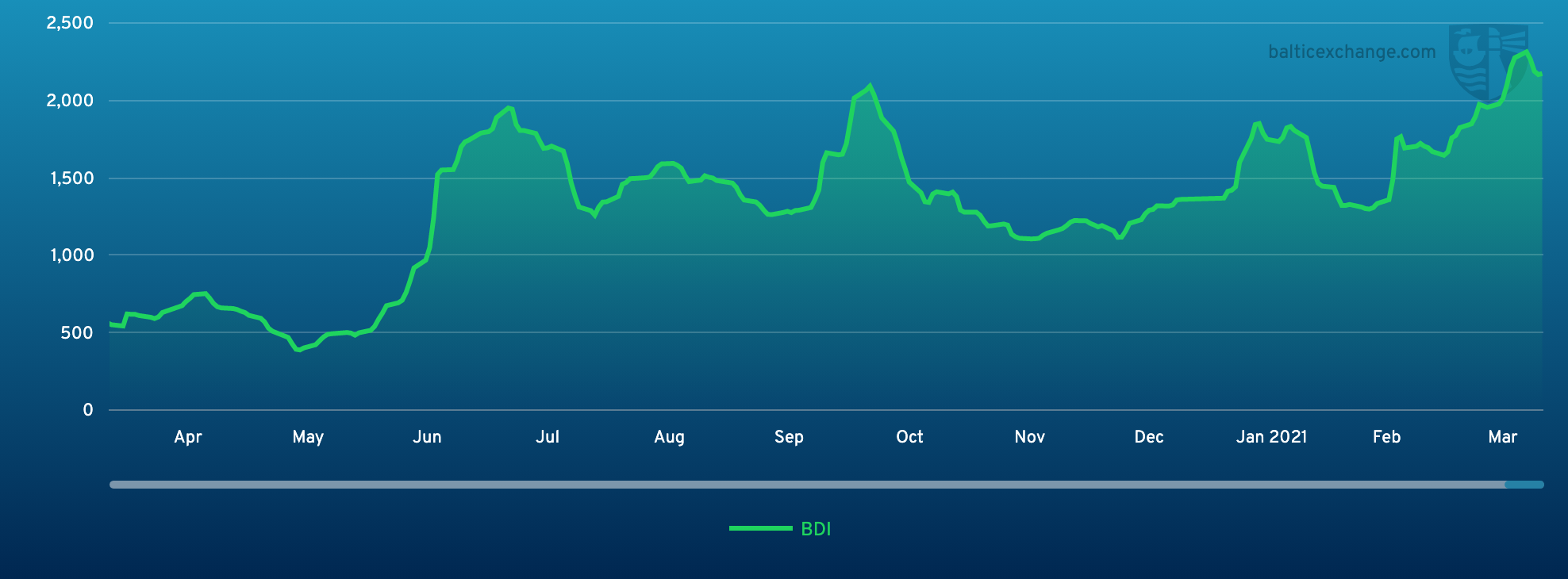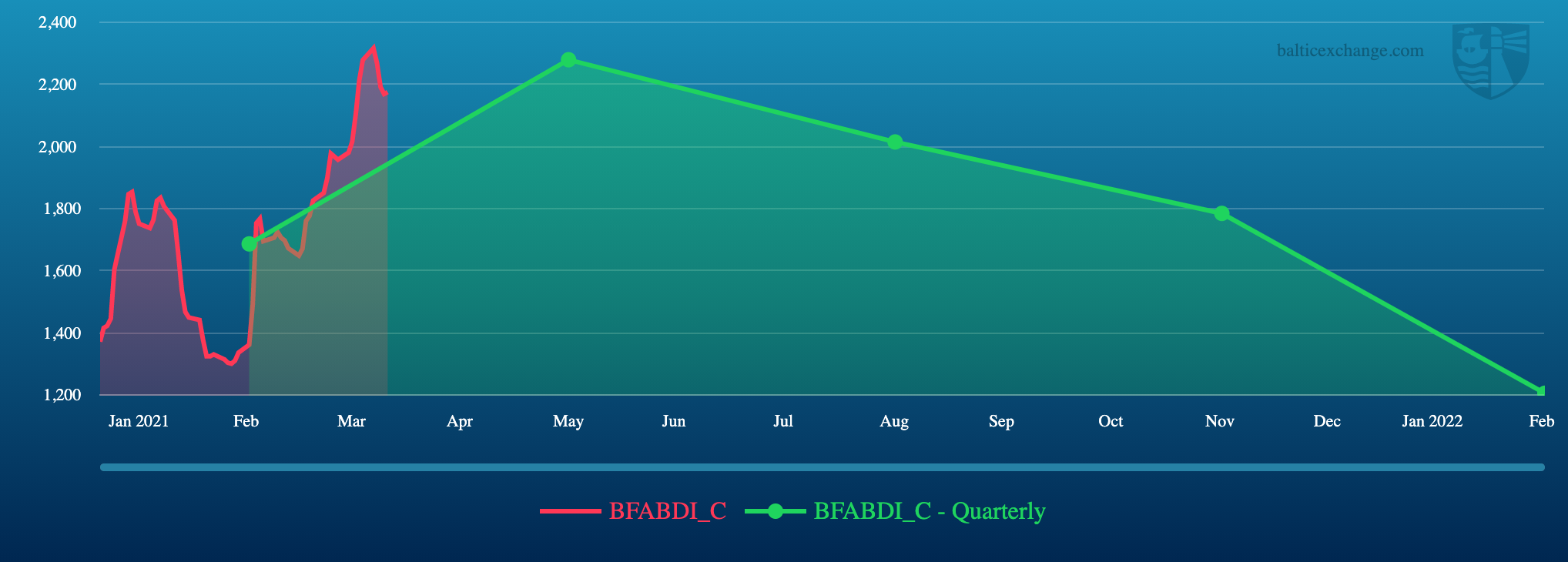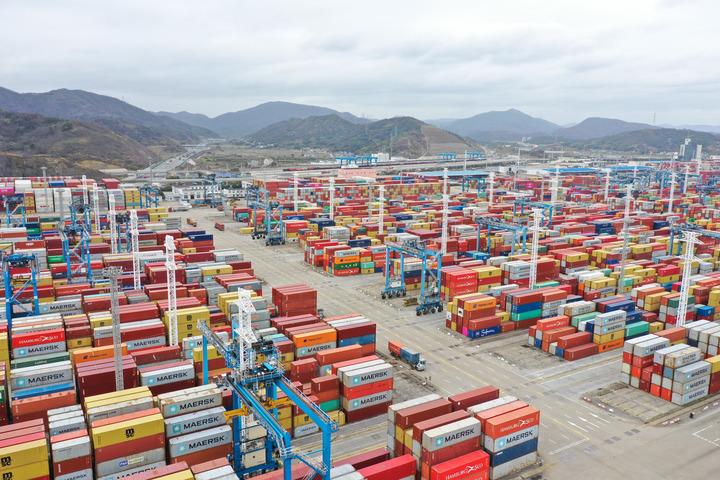BEIJING, March 29 (Xinhua) -- The Baltic Exchange has published its weekly report of the dry and tanker markets for March 22-26, 2021 as below:
Capesize
A more tempered week saw rates soften across all routes with low activity in both basins. Resilience and strong optimism still remains from Owners, yet the tailwinds from smaller classes turned to headwinds early in the week as market sentiment across shipping and commodities took a downward turn. The Capesize rates followed suit through until Thursday before posting a small up-tick. The 5TC opened the week at $19,437 to close out the week down $423 at $19,014. The Brazil to China C3 was slightly down $0.71 to $21.04 and the West Australia to China C5 was down $0.104 to $9.223. Both very modest drops with Owners showing no signs of panic. News out of Vales northern Brazil rail line had iron ore cargoes being impacted by a slip incident yet flow continues.
Panamax
The Panamax 5 time-charter average yielded a loss of $1,326 on the week to publish on closing at $25,447, which is a realistic reflection of the corrective week the Panamax market has experienced following last week's dramatic rises. Rates in the Atlantic basin eased as demand faltered and pressure slowly built on the nearby position with fewer options for Owners to consider. The Asian market proved to be something of a two-tier market, the north supported with healthy grain demand ex NoPac with rates typically around $29/30,000 for 82,000dwt agreed occasionally. Further south, pressure built in the southern positions with limited activity here. The resultant large spread between the bid and offer curtailed activity with nearby tonnage reducing rates in order to get fixed. Late in the week there were some murmurs of a rebound, aided by renewed support in FFA's. It will be interesting to see how this plays out next week.
Ultramax/Supramax
There was a change of direction with rates easing in most areas including Asia. Despite the overall negativity, news of period activity still surfaced with a 63,000dwt new building being fixed for one year at $20,500. The Atlantic saw less fresh enquiry from the US Gulf, a 58,000dwt fixing a petcoke cargo to west coast central America at around $26,000. Further south, rates from east coast south America eased as well, a 57,000dwt being linked to a trans-Atlantic run in the mid/upper $20,000s. In Asia a 63,000dwt was reported fixed basis delivery Singapore for a trip via Indonesia redelivery India at $28,500. Otherwise a 55,000dwt fixed a trip basis delivery south China via Philippines with nickel ore redelivery south China in the mid $20,000s. There was still enquiry from the Indian Ocean. A 58,000dwt fixing a coal run from Richards Bay to west coast India at $16,250 plus $625,000 ballast bonus.
Handysize
At the beginning of the week, the BHSI had its first decline since mid January and the trend continued for the rest of the week. The Atlantic basin largely softened with all routes losing value. East coast South America moved sharply lower and broke the barrier of $30,000/day on the relevant HS3 route in the middle of the week. There was a feeling of limited cargoes whilst the tonnage was building up and some brokers commented on more vessels ballasting down to east coast South America from the US Gulf to perform trans-Atlantic cargo. The market in east remained firm according to the fixtures reported. The difference on rates between Far East delivery and Southeast Asia delivery appeared to be minimal. All of the Pacific routes are still currently at the highest level since 38,000dwt was used as the benchmark vessel in January 2020.
VLCC
Rates have firmed in all sectors. In the Middle East the market for 280,000mt Middle East to US Gulf trip (routing via the Cape/Cape) is assessed almost a point higher at WS19, while rates for 270,000mt to China have improved 4.5 points to about WS33-33.5 level, which shows a TCE basis round trip of around $$1,300/day. In the Atlantic, rates for 260,000mt West Africa to China saw a similar 4.5 point improvement to WS37.5-38 level (a TCE of about $7.2k/day round trip) and 270,000mt from US Gulf to China saw rates climb over $350k to $4.78m ($11,800/day TCE round trip).
Suezmax
The well-publicized Suez blockage incident has helped bolster an improving sentiment in this asset class. In the 135,000mt Black Sea/Med market rates have risen 11 points to the WS90 level (approx. $18,500/day TCE) with Owners continuing to benefit from a tight Mediterranean Aframax market, where the main focus is a firm vessel itinerary. In the 130,000mt Nigeria/UK Continent market, rates gained 7.5 points to WS77-78 level (~$15.5k/day TCE), while Petroineos are reported to have taken a ship on subjects at WS80 albeit for an early April loading. The market for 140,000mt Basrah/Med increased by about six points to WS27.5.
Aframax
In the Mediterranean, Owners of vessels with clear itineraries are in control and are driving the market upwards, seeking better than the last done on each fresh cargo. Rates for 80,000mt Ceyhan/Lavera have risen 18 points to WS145 level (a TCE of $28,500/day basis a round voyage). It has been a different story in Northern Europe, with 80,000mt Cross-North Sea rates falling back nine points to WS110 level (approx. $12,200/day TCE) and the market appears to have settled here for now as the sentiment in the Mediterranean is starting to have a knock-on effect. Meanwhile, rates for 100,000mt Baltic/UK Continent fell harder, seeing a drop of 27.5 points to about WS100. On the other side of the Atlantic, Charterers appear to have regained control and have managed to push rates back down. In the 70,000mt Caribbean/US Gulf market, rates have collapsed 35 points to WS95 (a TCE of about $5,000/day) while for 70,000mt US Gulf/UK Continent rates are now at the WS75 mark, having tumbled by just shy of 30 points.
Clean
It has been another encouraging week for LR Owners where rates for 75,000mt Middle-East Gulf/Japan climbed just over 40 points to WS 137.5 and brokers feel there is potential for further increases. The LR1 market also improved but by a somewhat more modest 7.5 points and now sits at WS130. Whilst it was a slower week the tonnage list is much better balanced now. For MR's in AG/East Africa trade rates came under downward pressure ending at around WS170 region having started the week in the high WS180s. Whilst for Cont/USAC, it has been a disappointing week with the market easing 15 points to WS155 and there is even talk of WS152.5 now being agreed on subjects. Unsurprisingly, the MR market into West Africa followed suit and rates weakened from just shy of WS180 to sit now in the low/mid WS160s. In the 38,000mt backhaul trade from US Gulf to UK-Continent, it was rather a dull week with the market shedding 2.5 points to WS67.5 while the US Gulf /Brazil trade was flat at WS110. Owners have seen a healthy improvement in the 30,000mt cross-Mediterranean trade with plenty of activity and the market has gained almost 70 points to mid WS190s aided also by plenty of Black Sea enquiry, and for March loading in the Mediterranean the feeling is rates could nudge WS200 region.
Headquartered in London and a subsidiary of the Singapore Exchange (SGX), the Baltic Exchange publishes a range of indices and assessments which provide an accurate and independent benchmark of the cost of transporting commodities and goods by sea. These include the Baltic Dry Index (BDI), the dry bulk shipping industry's best known indicator. Published daily since 1985, this provides a snapshot of the daily spot market earnings of capesize, panamax and supramax vessel types on the world's key trading routes.

Chart shows Baltic Dry Index (BDI) during March 27, 2020 to March 26, 2021

Baltic Forward Assessment for BDI
In March 2018 the BDI was re-weighted and is published using the following ratios of timecharter assessments: 40 percent capesize, 30 percent panamax and 30 percent supramax. The information is provided by a panel of international shipbrokers.
(Source: The Baltic Exchange, edited by Niu Huizhe with Xinhua Silk Road, niuhuizhe@xinhua.org)




 A single purchase
A single purchase









